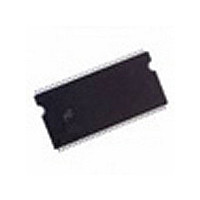MT46V32M16D2TH-7L Micron Technology Inc, MT46V32M16D2TH-7L Datasheet - Page 9

MT46V32M16D2TH-7L
Manufacturer Part Number
MT46V32M16D2TH-7L
Description
Manufacturer
Micron Technology Inc
Type
DDR SDRAMr
Datasheet
1.MT46V32M16D2TH-7L.pdf
(70 pages)
Specifications of MT46V32M16D2TH-7L
Organization
32Mx16
Density
512Mb
Address Bus
15b
Access Time (max)
750ps
Maximum Clock Rate
266MHz
Operating Supply Voltage (typ)
2.5V
Package Type
TSOP
Operating Temp Range
0C to 70C
Operating Supply Voltage (max)
2.7V
Operating Supply Voltage (min)
2.3V
Pin Count
66
Mounting
Surface Mount
Operating Temperature Classification
Commercial
Lead Free Status / Rohs Status
Not Compliant
FUNCTIONAL DESCRIPTION
dynamic random-access memory containing
536,870,912 bits. The 512Mb DDR SDRAM is internally
configured as a quad-bank DRAM.
architecture to achieve high-speed operation. The
double data rate architecture is essentially a 2n-prefetch
architecture, with an interface designed to transfer two
data words per clock cycle at the I/O pins. A single read
or write access for the 512Mb DDR SDRAM consists of
a single 2n-bit wide, one-clock-cycle data transfer at the
internal DRAM core and two corresponding n-bit wide,
one-half-clock-cycle data transfers at the I/O pins.
burst oriented; accesses start at a selected location and
continue for a programmed number of locations in a
programmed sequence. Accesses begin with the regis-
tration of an ACTIVE command, which is then fol-
lowed by a READ or WRITE command. The address
bits registered coincident with the ACTIVE command
are used to select the bank and row to be accessed (BA0,
BA1 select the bank; A0-A12 select the row). The ad-
dress bits registered coincident with the READ or WRITE
command are used to select the starting column loca-
tion for the burst access.
be initialized. The following sections provide detailed
information covering device initialization, register defi-
nition, command descriptions and device operation.
Initialization
in a predefined manner. Operational procedures other
than those specified may result in undefined opera-
tion. Power must first be applied to V
simultaneously, and then to V
V
latch-up, which may cause permanent damage to the
device. V
expected to be nominally coincident with V
for CKE, inputs are not recognized as valid until after
V
an LVCMOS LOW level after V
ing an LVCMOS LOW level on CKE during power-up
is required to ensure that the DQ and DQS outputs
will be in the High-Z state, where they will remain until
driven in normal operation (by a read access). After all
power supply and reference voltages are stable, and the
clock is stable, the DDR SDRAM requires a 200µs delay
prior to applying an executable command.
LECT or NOP command should be applied, and CKE
512Mb: x4, x8, x16 DDR SDRAM
512Mx4x8x16DDR_A.p65 – Rev. A; Pub 10/00
TT
REF
The 512Mb DDR SDRAM is a high-speed CMOS,
The 512Mb DDR SDRAM uses a double data rate
Read and write accesses to the DDR SDRAM are
Prior to normal operation, the DDR SDRAM must
DDR SDRAMs must be powered up and initialized
Once the 200µs delay has been satisfied, a DESE-
). V
is applied. CKE is an SSTL_2 input but will detect
TT
REF
must be applied after V
can be applied any time after V
DD
REF
is applied. Maintain-
DD
(and to the system
Q to avoid device
DD
and V
DD
TT
Q but is
. Except
DD
Q
9
should be brought HIGH. Following the NOP com-
mand, a PRECHARGE ALL command should be ap-
plied. Next a LOAD MODE REGISTER command
should be issued for the extended mode register (BA1
LOW and BA0 HIGH) to enable the DLL, followed by
another LOAD MODE REGISTER command to the
mode register (BA0/BA1 both LOW) to reset the DLL
and to program the operating parameters. Two-hun-
dred clock cycles are required between the DLL reset
and any READ command. A PRECHARGE ALL com-
mand should then be applied, placing the device in the
all banks idle state.
must be performed (
ally, a LOAD MODE REGISTER command for the
mode register with the reset DLL bit deactivated (i.e., to
program operating parameters without resetting the
DLL) is required. Following these requirements, the
DDR SDRAM is ready for normal operation.
Register Definition
MODE REGISTER
of operation of the DDR SDRAM. This definition
includes the selection of a burst length, a burst type, a
CAS latency and an operating mode, as shown in
Figure 1. The mode register is programmed via the
MODE REGISTER SET command (with BA0 = 0 and
BA1 = 0) and will retain the stored information until it
is programmed again or the device loses power (except
for bit A8, which is self-clearing).
contents of the memory, provided it is performed
correctly. The mode register must be loaded (reloaded)
when all banks are idle and no bursts are in progress,
and the controller must wait the specified time before
initiating the subsequent operation. Violating either of
these requirements will result in unspecified operation.
specifies the type of burst (sequential or interleaved),
A4-A6 specify the CAS latency, and A7-A12 specify the
operating mode.
Burst Length
burst oriented, with the burst length being program-
mable, as shown in Figure 1. The burst length deter-
mines the maximum number of column locations that
can be accessed for a given READ or WRITE command.
Burst lengths of 2, 4, or 8 locations are available for
both the sequential and the interleaved burst types.
Once in the idle state, two AUTO REFRESH cycles
The mode register is used to define the specific mode
Reprogramming the mode register will not alter the
Mode register bits A0-A2 specify the burst length, A3
Read and write accesses to the DDR SDRAM are
Micron Technology, Inc., reserves the right to change products or specifications without notice.
t
RFC must be satisfied.) Addition-
512Mb: x4, x8, x16
DDR SDRAM
©2000, Micron Technology, Inc.
ADVANCE
















